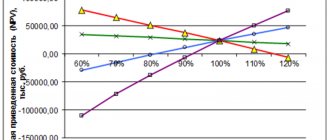The success of a future project directly depends on the approach to its implementation. The starting point for starting financial activities is clear development planning.
Many budding entrepreneurs do not attach importance to this. Due to the lack of special knowledge in the field of market economics, inexperienced businessmen doom themselves to extra costs to develop their activities.
A business plan is a document that details the development strategy. It defines the main goals and describes step by step ways to achieve them in the shortest possible time.
There is no specific strictly established form for drawing up a business plan. Each company or entrepreneur may have it compiled differently. It depends on the goals and scope of future activity. Most financiers, when writing it, recommend adhering to the following generally accepted points:
- Front page;
- Summary;
- Brief information about the business;
- Description of goods and services produced;
- Market and competitor analysis;
- Basic marketing strategy;
- Production plan;
- Financial plan;
- Analysis and risk assessment with insurance programs;
- Applications.
What is a Work Breakdown Structure?
Once you start planning your project, the first thing you do is determine the work that needs to be done. A work breakdown structure (WBS) is what you use to divide the work of a project into separate parts. Creating a WBS helps the project in several ways:
- First, it is easier to estimate time and cost for smaller pieces of work;
- Secondly, it is easier to assign work to team members;
- Third, by breaking down work into smaller pieces, you build milestones into your project that allow you to measure progress.
The WBS contains two types of tasks: Summary tasks and work packages . Summary tasks are higher-level tasks that somehow summarize the work of the project. Summary tasks can describe each part of the project, in our example this is updating the conference center equipment, renovating spaces, and so on.
The number of levels of summary tasks depends on the size of the project. A few levels will be enough for a small project. In a large or complex project, you may have many levels of summary tasks.
Work packages are the lowest level tasks in the work breakdown structure. They describe the results of the project and the details of the work required to achieve the result. In our example, under Install Hardware, work packages might include cabling, rack setup, hardware placement, hardware configuration, networking, and testing.
About the key elements of success
The need for this section arises when the developer believes that several additional arguments are missing to be convincing.
The complexity of the project and a large number of factors that have a significant impact on its implementation lead to the fact that successful final implementation begins to seem doubtful to the investor. Therefore, it makes sense to highlight objective factors and circumstances that favorably influence the course of events . In addition, here you need to indicate the main measures that, according to the developers of the business plan, will achieve the desired result.
Building a work distribution structure
The best way to build a work breakdown structure is to start at the top and work your way down. By apex we mean the top level of summary tasks. For larger projects, you may want to work as a team to define the top few levels of summary tasks. The team can then split into smaller groups to break down the summary tasks into smaller pieces. At the end, everyone comes together to review the results and correct any discrepancies.
Start by using the scope and results statement to define top-level summary tasks. For example, because the scope of a conference center includes updating the conference center equipment and renovating the conference center rooms, you add summary tasks to solve them.
Then break each of the summary tasks into smaller parts. This is where intermediate results are useful for defining summary tasks and lower-level work packages. For example, a convention center project includes a checklist for signing contracts with third parties. This includes receiving proposals, selecting suppliers, agreeing and signing contracts.
You may be wondering how many levels a project should be broken down into. The golden rule that most project managers use is to create work packages that take between eight and 80 hours to complete. Consider breaking down the work into projects to match the frequency of your status reports. With this approach, progress will be much more noticeable, and tasks will be completed just before the project progress report is compiled.
You can use the following assessment to see if you have broken down the work correctly. Time and cost are easy to estimate. Condition is easy to measure. Different parts of the project may require different levels of allocation. One part of the project may involve more work, so you may want to break it down into three levels. If another part of the project is simpler, you may only need two levels. Don't worry about the initial organization of your WBS; you can change it later as you learn more about the project.
Applications
Competently create a business plan from scratch - how to do a coursework. It seems like it should be, but when you imagine how much to write and insert, you put it off until later. I want to make things easier and save time. These programs already have the structure and necessary diagrams for a business plan:
- Project Expert,
- Business Plan PL,
- “Business planning workshop”,
- COMFAR III Expert,
- Business Plan Pro,
- "Alt-Invest"
Enter the original numbers. The program will calculate the rest itself.
How to create work packages?
To give your team the information they need, create work package documents that detail the work defined in the WBS. The level of detail you include in a work package document depends on things like familiarity with the job and the experience of the person assigned to the task.
For example, for a less experienced worker, you can create a more detailed list of tasks, on the other hand, for an experienced worker, you can create a checklist of what needs to be done. If the specifics of the work are described elsewhere, you can refer to another document that contains such information.
The work package document does more than just describe the work. It also determines how you will know that a task has been completed and whether it was completed correctly. For some tasks, you may want to include appropriate success criteria. Or add a description of what should happen when the task is completed.
Project time and cost estimation
In projects you measure two things: time and cost. You estimate time because it affects both the project schedule and cost. You also estimate expenses that are not time-based, such as supplies you need or travel.
During initiation and planning, you work with a core planning team made up of people knowledgeable about the project. This planning team helps you develop your initial estimates. Later, during the project, you can get more accurate estimates from the people assigned to specific tasks.
Grades don't have to be perfect. A score of plus or minus 75% may be sufficient to select a project. As you learn more about the project during planning and execution, your estimates become more accurate, ideally to within 10%.
There are several methods you can use to estimate. Whenever possible, base your estimates on similar projects that have already been completed. If you are faced with an unknown project, then consider bringing in experts familiar with the work, such as consultants.
With parametric models, you calculate work and cost based on some measure, such as the number of square meters to build, for example. This method works well when you have data from many similar projects.
The Project Evaluation and Review Technique, abbreviated as PERT, uses the best, worst, and most likely outcomes to evaluate a project. This is a good approach if the project is unfamiliar or has a lot of uncertainty.
Now let's talk about how the Delphi technique works. To begin, you ask several experts to create estimates independently of each other. You then share the results with the group, keeping the scores anonymous to prevent any influence on the outcome.
Next, you will ask each assessor to re-evaluate. Repeat this step a few more times and then use the average of the last session as your final estimate.
You can estimate the cost of a project using top-down or bottom-up methods. Top-down estimating is effective for large projects or preliminary estimates. You estimate phases, or major components, and then break those estimates down into smaller pieces until you get to individual tasks. Bottom-up estimating means you estimate each task and then add them up until you get an estimate for the entire project.
Using the project you're working on, determine which estimation method makes the most sense, and then identify the people who can help you evaluate it. Finally, ask management to set aside time and money for contingencies so you can proactively address issues that arise.
Conclusion
A complete strategic development plan for an enterprise includes the following sections:
- The results of the analysis of the external and internal context of the organization at the time of development of the plan.
- Description of current activities and long-term development goals of the organization.
- Description of the company's mission and development strategies.
- Functional strategies of company divisions.
- Description of projects for the development of the company.
- Business plans for the implementation of development projects.
- Description of risk management methods for implementing the strategic plan.
Development of a strategic development plan is the basis for choosing long-term goals of the enterprise and ways to achieve them. Strategic planning helps to effectively allocate and use company resources to achieve the main goals and objectives of the chosen mission.
Please note: it is necessary to systematically monitor the approved plan so that it does not lose its relevance, and conduct an audit of the company’s strategies, since the market situation and internal processes of the company can change significantly under the influence of factors that did not manifest themselves at the time of development of the strategic plan. It is better to quickly identify the ineffectiveness of the chosen path than to stubbornly continue to waste the company’s time and resources on achieving a goal that has lost relevance.
At its core, strategic planning is an ongoing process in which a company must find the shortest and most effective path to success.
Creating a Resource Management Plan
In a resource management plan, you define and document the roles and responsibilities on the project, who reports to whom, and the skills needed to complete the work on the project. The resource management plan also includes a staffing plan that describes all stages of staff involvement in the project.
First, create a Responsibility Matrix. The responsibility matrix defines who will make or approve decisions, the teams performing the work, and which teams should be consulted or informed about what is happening in the project.
The responsibility matrix includes four categories of responsibility:
- The group that is responsible for getting the work done;
- The group that receives the information;
- An advisory group with whom you discuss decision making.
- A group that makes or approves decisions and delegates work.
If you use resources from other organizations, such as outsourcing, subcontracting, or partnering, record how each of these groups contributes in your responsibility matrix.
The second step in creating a resource management plan is to create a project organizational structure that shows the hierarchy and reporting structure for the people involved in or working on the project. It defines the chain of command so you know who to talk to if you need to expedite a request or decision.
Determine the type and number of experienced team members needed for the project. The skills matrix is the tool you use to determine these resource requirements.
To create a skills matrix, you need the following:
- Review your work packages and determine the skills required for each;
- Create a matrix with your project tasks in the rows and the skills you need in the columns;
- Mark those places where tasks require a specific skill;
- Estimate the amount of resources needed for each skill.
| Tasks | Business knowledge | Management | Design | Interior design | Equipment installation | Repair work |
| Setting Requirements | x | x | x | x | ||
| Contact suppliers | x | |||||
| Design update | x | x | ||||
| Equipment installation | x | |||||
| Interior design | x | x | ||||
| Repair work | x | |||||
| Testing | x | x | ||||
| People need | 1 | 1 | 2 | 1 | 8 | 5 |
| Weekly rate | 15,000 rub. | 14,000 rub. | 8,000 rub. | 9,000 rub. | 5,000 rub. | 9,000 rub. |
| Estimated number of weeks | 2 | 4 | 4 | 1 | 6 | 6 |
| Total | 30 000 rub | 56 000 rub | 64 000rub | 9 000rub | 240 000rub | 270 000 rub |
Total: 669,000 rubles
Once you estimate how many resources you need, you multiply that number by the average pay rate to estimate the cost of labor.
In the third planning step, you develop a detailed staffing schedule. In this plan, indicate where you plan to source resources, such as locally or outsourced. Determine any training requirements for resources involved in the project. Document processes so everyone knows what to do in their area. Manage people and release them from the project when their work is completed.
A resource management plan documents who does what, who reports to whom, what resources you need, and how you will manage them while they are part of your team.
Creating a project schedule
A work breakdown structure defines the work people must do to complete a project, but it doesn't tell you how long the work will take or when it can be completed. To do this, you need to turn your task list into a schedule.
First, place the tasks in the correct sequence. That is, indicate which tasks must complete before others begin, which tasks will begin or complete at the same time, and so on. For example, you cannot connect equipment to the network until the equipment is installed and the cables have been routed.
To organize tasks, you specify dependencies between project tasks. We'll look at dependencies in more detail a little later. By far the most common type of dependency is end-start.
Second, you need to estimate the time each task will take. Time estimates and the order in which tasks are completed help determine how long the entire project will take. You must estimate as accurately as possible because underestimation and overestimation lead to problems in the project.
Third, you need to identify the people on your project team and assign them to tasks. With proper timing and people assigned to the job, you can calculate the duration of the task.
Finally, take into account other constraints such as timing and resource availability. If your initial schedule doesn't quite meet your expectations, you can adjust it in several ways, whether you're trying to shorten your schedule, cut costs, or balance employee workloads.
Example resume
Theoretical guidelines are useful because they provide a general idea and give direction to the work. However, a practical example is much clearer. Consider a summary for a hair salon business plan:
“Project of the family hairdressing salon “Quick Scissors”
IP Ivanova Maria Andreevna, INN..., address, telephone. Taxation - simplified tax system "Income".
Description of the project - a family hairdressing salon with quick service (up to 20 minutes) and a fixed cost of services (200 rubles). Work without prior appointment. The market for hairdressing services is crowded, however, none of the competing organizations offers clients such conditions.
The goal is to create a convenient service for visitors to the shopping center and make a profit from popular services, regardless of the season.
Location - first floor of a shopping center, 20 sq.m (for rent). A prime location attracts more visitors, as does the lack of an appointment. The terms of service provide an incentive to get a haircut “here and now.”
Team - 5 hairdressers. This quantity ensures uninterrupted operation seven days a week from 10:00 to 22:00 (coincides with the work of the shopping center).
Potential clients are visitors to the shopping center, regardless of gender and age.
Starting investment - 200 thousand rubles:
- rent of premises (3 months);
- purchase of equipment;
- sign making;
- online cash register rental.
Expected revenue for the first month is 120 thousand rubles (20 clients daily). Profit - 40 thousand rubles.
The full payback of the project is 6 months.”
Creating a project budget
Project cost is one of the three key constraints you need to address. And the project budget is your starting point. The project budget should reflect a realistic estimate of the cost of the work you have identified in the work breakdown structure. If your estimate is unrealistically high, the project may be cancelled.
If the estimate is too low, the project will not be financially beneficial. You estimate the total cost of the project by calculating all costs associated with completing the project work, including labor, materials, and other expenses such as travel.
At the beginning of a project, you can estimate the costs for the first few levels of your work structure to get a rough estimate of the project's budget. You can then create more accurate estimates as you learn more about the project.
Labor costs usually account for the majority of the project cost. If you hire suppliers or contractors, their costs go directly toward labor on the project. Employees are generally paid their salaries and benefits.
Projects may use other types of temporary resources, such as equipment or office space that you rent. Include this equipment and other time costs in your calculations.
Finally, be sure to include other types of support expenses that don't fit into the previous three categories. For example, travel expenses, training expenses and registration fees fall into this category.
In most projects, management allocates money for the project. If your cost estimate exceeds the allocated amount, you may need to consider how to reduce the cost of the project. For example, you can eliminate unnecessary expenses, find less expensive resources, reduce volume, etc. The project budget is the target to which you need to strive when managing a project.
Identifying project risks
Every project faces risks. If you don't plan how to deal with them, you spend too much time on all sorts of fixes, and this can cost your project time and money. To avoid this, you must first identify the risks your project faces.
There are two categories of risks – “known unknowns”, which can be identified and analyzed, and “unknown unknowns”, which cannot be identified and a response can be planned. Some examples of risks that often arise in projects:
- The complexity of the technology, its malfunction or its inflated cost;
- A dispersed global team increases decision-making time due to time zone differences. Difficulty in communication due to cultural differences and language barriers;
- Ineffective teamwork due to incorrect distribution of roles;
- Limited opportunities due to the need for people with rare skills.
Try to work with all members of your team to identify risks. Talk to experts from different parts of the project about the risks they can foresee. Ask key people on the project what they think, and ask other project managers about the risks of similar projects.
For each risk you identify, fill out a form with information about it, such as what tasks are affected, what targets are at risk, what the consequences are, and so on.
So far we've looked at the risks we can foresee, but what do you do about the risks you can't predict, called "unknown unknowns"? These risks come from situations that are so out of this world that they would never happen to you.
Since you can't identify these risks, you deal with them by setting aside funds for unexpected expenses. Reserve funds are a widely used method of responding to "unknown" risks that you cannot predict, as well as small risks that are predictable. The question is how much should you allocate? Many companies use a percentage of the project budget, but the percentage used is usually based on past experience.
If risks arise, they may impact your project, such as causing delays or increasing costs. To minimize the impact of downside risks or reap their benefits, you first need to identify the risks your project faces.
Creating a project risk management plan
Once risks have been identified, the next step in developing a risk management plan is to analyze each risk you identify. Risk analysis comes down to asking two questions. First ask, what is the probability that the risk will occur? For example, modern technologies are known to be problematic, so technological risks are likely. The second question is: How big is the impact on the project if this happens?
Once you have analyzed all the risks, the next step is to prioritize the risks and determine which ones you are going to manage. For example, if you divide the probability of risks into low, medium and high, then you can decide to manage risks if their probability or impact is medium or high.
The next step in your risk management plan is to determine how you will respond to each risk in your plan:
- The easiest option is to simply accept the consequences. This is good for risks with low probability and impact.
- Another option for less significant risks is to use contingency funds to address the issue.
- Avoiding risk is another approach. For example, changing the project scope to remove a risky part in the project or, for example, you can reserve enough time to replace a broken technology with the least impact on the progress of the project.
- Reducing risk means taking steps to reduce the consequences. For example, by creating a prototype, you will find out if the technology works at an early stage.
- Risk transfer simply means transferring the risk to a third party, as is the case with insurance.
The final step in the Risk Management Plan is determining how to control risks and how to respond to them. You create a risk log with information about each risk you plan to manage. This log summarizes your plan for each risk, a description of the risk, the events or circumstances that give rise to the risk, the response action you chose, and the result you expect to get from the action if you were to use it.
| Risk number | Description | Trigger | Opportunity | Influence | A priority | Responsible | Response actions | Expected results | Status | Notes |
| 1 | New equipment doesn't work | Testing | High | High | 1 | Andrey | soften | The prototype must determine whether the equipment works | Observation | |
| 2 | New technology requires major renovations | Design | Average | Average | 4 | Elena | Reserve funds | Additional funds cover the cost of reconstruction | Plan developed | |
| 3 | New equipment not available | Placing an order for equipment | Average | High | 2 | Yuri | To avoid | Create a schedule for receiving equipment on time | Observation | |
| 4 | Technology may become obsolete before the project is completed | Release of a completely new technology | Average | High | 3 | Andrey | Transfer | The contract with the supplier includes a clause for the replacement of any obsolete technology | Observation | |
| 5 | Possibility of cost overruns | Design | Average | Average | 5 | Elena | soften | Finding Alternatives to Contain Costs | Observation |
Creating a Quality Management Plan
During planning, you must consider the quality that stakeholders want from the project results or final product. A quality management plan ensures that your project meets the required quality. Project quality means meeting customer requirements and completing it on time and within budget.
The quality management plan consists of three components:
First, define quality standards for specific deliverables. For example, product quality may include acceptable dimensions or the acceptable number of defective products in a lot. Keep in mind that the goal is to meet established quality standards.
Obviously, you don't want quality that is less than standard because... the customer simply will not accept the results of the project. You should also not strive to obtain quality above the standard, because... this may affect other project details, such as increasing the project schedule or increasing costs.
Second, develop a project quality assurance plan. That is, how will you demonstrate that quality standards have been met. For example, you may decide to test products coming off the production line to statistically determine the number of defective products in a batch.
You can also plan your project in such a way as to prevent defects from occurring. For example, you may choose a simpler design that will make the product easier to manufacture, thereby reducing the number of defects produced.
Third, you plan for quality control. That is, how will you control and measure quality. The idea is that you study or measure results to see if they meet established standards. Continuous improvement is an important part of quality management.
If you find quality problems, you can analyze them to see how to prevent them or at least reduce their frequency. For example, a cause and effect diagram, also called a fishbone diagram, helps identify factors that may lead to problems. In turn, these factors can help you find ways to prevent problems.
Another qualitative tool is the Pareto chart, which shows how many defects are caused by each cause. The chart lists causes by the number of defects they create, so you can eliminate the causes that cause the most defects first.
Ready economic indicators
Financial and economic indicators calculated and justified in the business plan are included in the red line in the summary of the business plan. This is why it is important to write this section of the plan at the very end. This paragraph specifies:
- Production volumes with deadlines (quarter, six months or year);
- Expected sales volumes;
- Planned level of production profitability;
- Indicators of use of production assets;
- Amounts of financing, both own and attracted;
- Amounts of contributions to budgetary and extra-budgetary funds;
- Planned number of employees (permanent or seasonal);
- Expected payback period for the project.
Unlike a business plan, a resume does not discuss pessimistic, optimal and optimistic development options. It is recommended to indicate exactly the expected indicators that are most likely at a given time.
Tips for drafting:
- To attract foreign investors, a summary of the business plan is created in English. This will help realize the project’s goals of introducing it to the global market and obtaining financing abroad.
- To protect the intellectual rights of a document from being used by others, it is better to indicate the level of confidentiality of the data contained therein.
- It is recommended to present the information presented concisely and at the same time as informatively as possible. There is no need to go deeper, just briefly describe the essence.
Building a change management plan
A change management plan will help you incorporate important changes into your project without considering those that don't make sense. First, you need to define the elements you want to control, such as the scope of the project, its requirements, or the entire project plan.
The items you manage are called base documents. For example, a list of project requirements approved by stakeholders is your baseline. If new requirements are proposed, you can use the change management process to decide whether to add them to the list of requirements or not.
You also need a group of people who review change requests and decide whether to approve them or not. This group is called the Change Review Panel and typically consists of key stakeholders such as the customer, the executive team, project teams, functional managers, team leaders, and the project manager.
After that, it's time to define the change management process that will be used when someone requests a change. The process your organization chooses depends on factors such as company culture and project size.
Below are the components that are present in most change management processes.
- The first step is to document and submit the change request. A standardized change request form that can be completed makes it easier to evaluate changes because each request contains the information necessary for the review panel to evaluate and make a decision. Typically, a change request form contains details about the requested change, the reason for the change, the business justification, and the results it is expected to produce.
- In the second step, someone must evaluate the request and its impact. As a project manager, you can assign this task to someone on your team. The evaluator begins by determining the need for change. If so, it decides whether the proposed approach is correct or whether an alternative would be better. The estimator evaluates the effort and cost that the change will require, the impact on the project, and whether it poses any risks.
- In the third stage, the change review panel reviews the evaluated change requests. She may reject the change request, ask the applicant to provide more details or reconsider the request, or accept the change request outright. If the board approves the change request, you update the underlying documents to reflect this.
- Finally, you keep track of where change requests are in your process. You can use the change request log to track the status of submitted requests. As the request progresses through all the stages, you update the log, which is responsible for the request, the impact score, the current state, and the actual impact.
You don't need to send every change request through the change management process. Instead, consider setting thresholds so team leaders can decide what to do with smaller requests. It is also a good idea to have a process for urgent changes that requires a quick decision at change review committee meetings.
Mistakes that all newbies make
I want to protect and warn you. It is possible to build a business from scratch and without education, but you need to avoid the following mistakes:
- Invest 10–30% of the required amount yourself. Investors are only willing to give 70–90%. Those who want to win a business at the expense of sponsors look like scammers or lazy people. Financial support is given to those projects where a businessman gives his all and works 100%. Investors are happy to support such people.
- Overlooked expenses. Due to inattention, haste, and lack of understanding of the production and sales processes, some costs bypass the financial plan. Most often these are transportation of goods, commissions, return of defective goods.
- Possible risks are poorly thought out. There is no solution to the problem in detail. Not everything is provided. The investor will not want to take such risks and will refuse sponsorship. And even if you find money, the first problem will bankrupt you, because you were not ready for it.
Before you finish your business plan, check it for these errors.
Development of a procurement plan
Acquiring products, services and skills can be much faster than trying to create everything yourself. When you decide to purchase products from outside your organization, you need to plan how you are going to do it. This is where the procurement plan comes into play.
- The first step in developing a purchasing plan is to determine what you need to purchase. For example, you need people with the necessary skills for your project. Or you need more people than are available in your organization. Or the project requires products and materials.
- Next, you document your procurement processes. The purchasing plan specifies who is doing the purchasing, whether it is the purchasing department, the project team, or a combination of both. It also describes the criteria for selecting suppliers: the selection process, the types of contracts you use, how to manage those contracts, etc.
- In the third step, you describe the purchasing decision process. To make an informed purchasing decision, it is important to understand your needs. Make sure your requirements are clear and prioritize to make it easier to choose products that meet your requirements. Before you make your final decision, think about the pros and cons of the purchase. For example, if completing your project quickly is critical, then purchasing is usually the preferred option.
- The last step of the purchasing plan is to list potential sellers who offer the products you need. Describe how you researched suppliers and contractors and the criteria you used to compile the list.
Purchasing planning ensures that you make smart decisions about whether to buy goods and services. This also helps make the procurement process smoother.
How to get approval for a project?
Now that you have a plan for the project, you need to get stakeholder approval to begin the project work. This approval is important because you need stakeholder buy-in to make the project successful.
Schedule a meeting specifically to obtain approval. The agenda for the meeting is simple. First, present the project plan so that stakeholders agree to it. If any problems arise, resolve them immediately. If serious disagreements arise, you may have to reschedule the signing process so you can reconsider your plan.
Once everyone agrees, have them sign the draft to confirm their agreement. If you can't get everyone in one place, a video conference or conference call will do, but ask them to provide the signed document by fax, email, or regular mail.
Signing a project plan is not like signing a legal document. You will never go back to your stakeholders and say, “But you signed it!” What matters is that stakeholders understand what the project is about and agree to it.
You can read the fifth part in the article: “Developing a project implementation schedule. Part 5"
What else is interesting to read?
Change Management
February 22, 2019
Poor change management in an organization can destroy promising...
32819
Basics of doing business. What a new entrepreneur needs to know
February 04, 2019
In this article we will look at the basics of doing business , such as profit, customers,…
31881
Making management decisions. Process, principles and implementation
November 30, 2018
Making managerial decisions by a manager is the main activity of management.…
30947
10 Basic Change Management Models
February 16, 2020
Change management is a proven methodology used to help...
14950
Interaction with clients. Stages of developing the right strategy
August 11, 2019
Customer service is the cornerstone of your business. This means that you...
14064
Why choose us?
| Execution speed | Profitable price | Qualification |
| Guaranteed price | Project translation | Your own format |
Our specialists have the necessary experience and will help you draw up a well-founded document that will reflect the main advantages of your business, identify growth potential and carry out a risk assessment.
We develop a business plan for an enterprise in a short time, while selecting the optimal document format based on your objectives.










